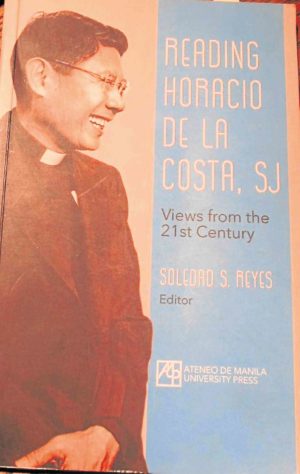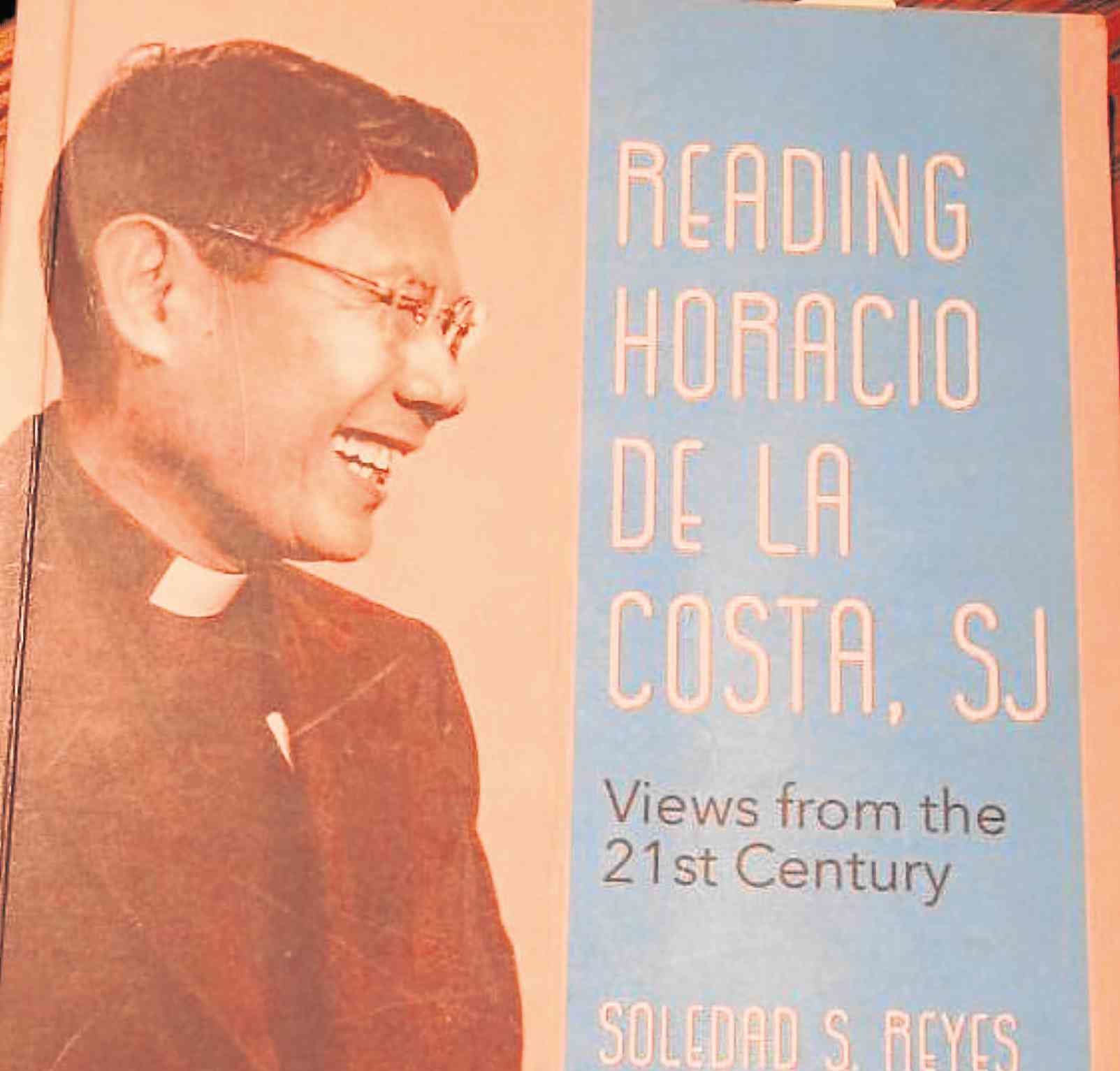 Great teachers—like a stone thrown into a still pond—have a deep rippling effect that goes far beyond their lifetimes.
Great teachers—like a stone thrown into a still pond—have a deep rippling effect that goes far beyond their lifetimes.
The Rev. Horacio de la Costa, SJ, passed away at age 60 in 1977 and would have turned 100 on May 9, 2016.
The first Filipino to become a Jesuit provincial and a well-known historian, he has a secure place in Philippine history. But it was his role as a teacher and original thinker that propelled his former students and followers to mark his centenary with commemorative lectures, events, exhibits, and now, a book, “Reading Horacio de la Costa, SJ: Views from the 21st Century.”
Edited by the eminent scholar Dr. Soledad Reyes, and under the aegis of Ateneo de Manila School of Humanities, the book compiles 11 essays based on the lecture series held in De la Costa’s honor in 2016.
From one perspective, the world of De la Costa and his contemporaries may seem outdated. Raised during the American colonial period and a brilliant student of the foremost Jesuit institution at that time, De la Costa may appear to represent conservative mores.
But Jesuits are educated to be tough and, as recollected by Fr. Catalino Arevalo, SJ, this training enabled De la Costa, then a young scholastic imprisoned in Fort Santiago by the Japanese, to survive gun butts and execrable conditions.
It also gave him the spirit to stand his ground in the 1960s, when history was being rewritten toward a more Filipino and secular view.
In the process
In a 1975 essay, “The Filipino: Identikit,” he wrote that the Philippines is (still) in the process of becoming a nation. “We must steel ourselves against the shock of finding ourselves in our part of the world a nation of Malay stock, socially structured on a basically Indonesian pattern, obviously the recipient of a large infusion of Chinese blood and attitudes, yet with a cultural heritage in part Spanish, in part Anglo-Saxon; for this nation will be ourselves.”
The concept of hybridity has continued to trouble Filipinos, who labor under the false impression that it simply implies the blend of two different species, resulting in a “mongrel” culture. They may not accept the fact that hybridity has also resulted in a new species that is both stronger and more adapted to a different environment.
Dr. Fernando N. Zialcita has suggested that we look to other cultures, such as that of Mexico, which has accepted its own mestizo makeup, as in the inscription at the Plaza de las Tres Culturas in Mexico City: “On 13 August 1521, heroically defended by Cuahtemoc, Tlatelolco fell into the hands of Hernan Cortes. It was neither a triumph nor a defeat; it was the painful birth of the mestizo people that is Mexico today.”
Zialcita has proposed updating the De la Costa statement to reflect our broadened views on Southeast Asian cultures: “We must steel ourselves against the shock of finding in our part of the world a nation whose matrix derives from both pre-Austronesian and Austronesian cultures, yet with cultural influences drawn from three continents: from Asia, largely the Chinese but also the Malay, the Arabic and others; from Europe, largely the Spanish but also others; from America, largely the Anglo-American and the Mexican but also others, for this nation will be ourselves.”
Inspired by De la Costa, Benito J. Legarda Jr. has likewise mentioned that we have to realize that “Filipino is not something in the historical past but that, to put it succinctly, Filipino is as Filipino does. We may not be identical with our distant ancestor, but we are still we, having assimilated the various elements introduced into our primitive society.”
Linked to the first point is the study of Philippine history, when it began, and our need to accept foreign elements that we have made part of our culture.
De la Costa was the counterpoint to the assertion made by the likes of Teodoro A. Agoncillo, Oscar Alfonso and Renato Constantino that there was no Philippine history prior to 1872 (the execution of Fathers Gomez, Burgos and Zamora) and that arguably, we could not rely on sources such as the Spanish to depict our own history, since these reflected Spanish viewpoint.
Anti-Eurocentric
According to Reynaldo C. Ileto, this anti-Eurocentric attitude dated back to Jose Rizal, who, in some of his writings, could have depicted the Spanish era as similar to the Dark Ages. It may be mentioned that in his reading of Morga, Rizal attempted to show that a Golden Age with high standards of civilization existed in the Philippines prior to the Spanish arrival.
De la Costa had responded to Agoncillo in the essay “History and Culture,” that “even if we were to concede that the history of the Philippines begins, or ought to begin, when the Philippines begins to be a nation (i.e., in 1872), it should be obvious that we cannot even begin to understand the Philippines as a nation unless we first understand it as a colony.”
De la Costa’s observations are relevant today to those who would wish us to move away from so-called “Western tradition” and more into the Sinic or Slavic spheres: “(i)t was through the mediation of Spain that the ideas of human equality, civic freedom and the rule of law, ideas Hellenic and Christian in origin, became an integral part of Philippine culture.
One does not have to realize that their rejection of colonialism had for its theoretical base not an Asian but a Western world view.
In short, the leaders of the propaganda movement, and Rizal, most of all, were the fated fruit of the Spanish conquest, the natural term of Spanish colonization, the Filipino whose emergence the Spanish conquistador and missionary not only made possible, but inevitable.”
Dr. Edilberto C. de Jesus has shown that going beyond history, De la Costa taught lessons that could still be significant even to those who serve in government, or who are responsible for analyzing our history or teaching it to educate our people.
De Jesus said: “The study of history sharpens one’s ability to mobilize the multiple meaning of words as weapons and to recognize the temporal context as a critical element in the analysis or implementation of the decision-making process…”
He remembers that “De la Costa taught me the importance of defining terms. Words matter. They have a dictionary meaning and a value that cannot easily be disputed. It is difficult, for instance, when President Duterte, in a televised speech, tells President Obama, ‘You can go to hell,’ for one to deny the hostility in the statement, especially when it is followed by declarations of the possible repudiation of bilateral treaties in existence.”
“Thinking in time” was a phrase popularized by Harvard professors Richard E. Neustadt and Ernest R. May, but De la Costa used it to instruct his students.
Failure to think in time has enabled Ferdinand Marcos Jr. to “project the period of martial law, over which his father presided, as the country’s golden age.”
Our lack of historical perspective has left us unable to properly judge in context the impact of the two Aquino administrations, as well as the 30-year succession to the Marcos years.
De Jesus asked, somewhat rhetorically, “Did the country enjoy greater peace and prosperity? Did the economy expand and provide a more equitable distribution of its fruits? Of special concern to urban residents, did traffic improve?”
Reflecting on Fr. Horacio de la Costa’s corpus of works, and the intellectual heritage that he left in his wake, makes us hope that we could apply some of those lessons to some very real threats that face us now, internally as well as externally.












































